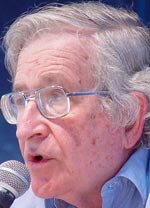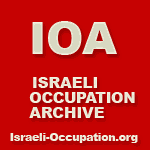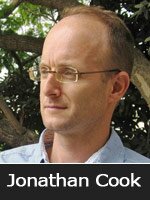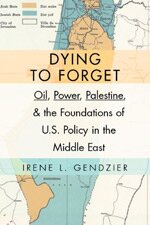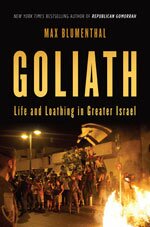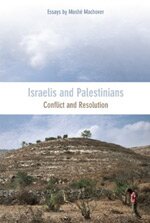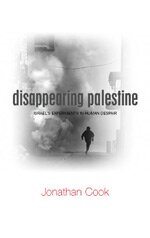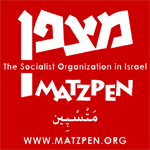Noam Chomsky has been awarded this year’s Sydney Peace Prize, Australia’s only international peace prize. In his City of Sydney Peace Prize Lecture, “Revolutionary Pacifism: Choices and Prospects,” Chomsky covers activist A.J. Muste’s concept of “revolutionary pacifism,” the principle of universality, and the long history of violent US behavior around the world, including the Middle East.
History
US Likudniks, who had remained relatively restrained on [book talks] until now, could not stand it any longer. They launched a massive attack against me in the form of a smear article … written by two Campus Watch vigilantes and first published on FrontPageMag… From there, the article was reproduced by countless websites and blogs belonging to the same ideological swarm, and distributed by them to their extensive email lists.
Assailants spray paint Mamilla Cemetery headstones with the slogans ‘Death to Arabs’ and the name of a settlement outpost slated for demolition. This is only the last in a series of violent activities against Palestinians and Israeli anti-Occupation activists.
IOA Editor: Mamilla Cemetery, a historic Jerusalem and Muslim landmark, has now been relegated by a junior Haaretz journalist to a site “next to the [yet-to-be-built] Jerusalem Museum of Tolerance.” The cemetery, containing centuries of Palestinian history, has been desecrated for decades by Israeli governments intent on eradicating Palestinian history. The museum, representing a distorted view of Jewish history, and imported from the US, is intended to physically replace yet another bit of Palestinian history — in Jerusalem, the very heart of Israeli-Palestinian contention. The Mamilla Cemetery case is crucially important: it is a very real, yet also a very symbolic, representation of Israeli ethnic cleansing in action.
Gilbert Achcar is Professor of Development Studies and International Relations at the School of Oriental and African Studies of the University of London; his latest work is The Arabs and the Holocaust: The Arab-Israeli War of Narratives. Achcar discusses what he calls the “Nazification” of the Arabs, what implications this narrative has had on the past and present political situation in the Middle East, and some of the context from which anti-Semitism and Holocaust-denial has taken root in a segment of Arab society.
The US and Israel have both been intent on forestalling the appearance of the Palestinian Authority before the UN, in case it succeeded in winning support for its unilateral declaration of Palestinian independence. This is a reversal of history: in 1948, the US regarded the prospect of an Israeli declaration of independence as a threat to its interests in the region, and the State Department, Defence Department and CIA were worried about such an outcome.
The mainstream of the Jewish public decided on its own, and without much internal reflection, that social justice could exist alongside a system of ethnic exclusivism. Thus, while the July 14 movement proceeded through cities across Israel bellowing out cries for dignity and rights, Palestinians remained safely tucked away behind an elaborate matrix of control — the Iron Wall. Ten years of separation had not only rendered the Palestinians invisible in a physical sense. It had erased them from the Israeli conscience.
IOA Editor: A very important article that puts Israel’s July 14 protest movement in an historical context: the Zionist settlement in, and occupation of, Palestine — before and after 1967. So far, there is no evidence that the massive wave of Israeli Jews calling for “social justice” has any intentions of improving the lives of Palestinian citizens of Israel. And it is absolutely clear that ending the Occupation is not on its agenda either.
Moshé Machover: “He had precisely what we lacked then – a consistent and comprehensive grasp of the Zionist settlement process and especially its impact on Arab society in Palestine. We acquired from him a deeper, more complete conceptualization of Israel as the realization of Zionist settlement. He also grasped the Arab Revolution as one indivisible process.”
Yasmin Dahr and Eilat Maoz put Israel’s July 14 Movement in its proper historical, social, and political context – something the protest movement’s loosely structured leadership has, so far, insisted on avoiding. Important analysis. (HEBREW)
What will the Palestinians do at the UN in September? The question appears to haunt Washington and Tel Aviv as they prepare to block Palestinian attempts to obtain UN recognition, as though the very idea of such action represents a form of political impudence that merits the harshest international rejection. Sober accounts by Palestinians of what they may expect from a trip to the UN have done little to allay the dark cloud of suspicion that is fostered in mainstream accounts.
The 2006 Edward Said Memorial lecture of Adelaide University,Australia, delivered by Tanya Reinhart on 7 October 2006. Tanya Reinhart covers important issues in this lecture: the Nakba in the history of the occupied and the occupier, the choice of armed- vs. unarmed struggle, Israel and South-Africa, the role of international activism, and what can be learned from both Edward Said and Nelson Mandela.
The kit called ‘How do you say Nakba in Hebrew?’ did not receive Israel’s Education Ministry’s approval and most of the teachers using it conceal their source.
The right wing considers recognition of the reality created in 1949 to be the chief enemy of Zionism. The dynamic of a conquering nationalism can never recognize that any situation created at any given time is final.
IOA Editor: Written from an Israeli-centered perspective, Sternhell focuses on the extreme “right” Zionism (Netanyahu, Yaalon, et al), correctly pointing out its dangerous and unstoppable nature. Unfortunately, he lets “mainstream” Zionism (not the subject of this article) go scot-free. In fact, much of what he says about “right wing” Zionism applies equally to “mainstream” Zionism. Perhaps the grass is greener when one conjures up the dream-images of what Zionism-Lite could/should have been. However, for the Palestinians, the harsh reality of dispossession and ethnic-cleansing of the past 100+ years was managed and carried out mostly by “mainstream” Zionism: some 77 years (about 40 years pre-statehood, followed by 37 of the past 63 years of Israeli statehood, including the 1967 war and subsequent occupation and settlement). Therefore, this article is important for the understanding of Zionism, both “right” and “mainstream,” not for the implied, and very limited, differences between them.
Israel is fighting against the memory of the Nakba, whereas others are searching for ways to give the Nakba its rightful place in teaching and education.
Why did the Arabs of Haifa flee in 1948? Didn’t Haifa’s Jewish mayor ask them to stay? Maybe because Haganah (the primary pre-state Jewish military organization in Palestine) mortar rounds shot at the midst of the civilian crowds in the market, spoke another language. Here is a story that Israeli historians do not like to tell. (HEBREW)
In the 1940s, with the understanding that a war is on its way, the Haganah (the primary pre-state Jewish military organization in Palestine) collected detailed intelligence on hundreds of Palestinian villages. Only a few dozen files survived in the archives, and in them images that teach a great deal about the way in which the Palestinian population at the time was viewed by the Jewish population. (HEBREW)
An interview with Alternate Focus: an analysis of the Israeli-Palestinian conflict and the Israeli occupation of Palestine, covering several of the most central issues.
Does history matter? Over the course of the past few months the Obama administration has abandoned its putative efforts to engage Israel and the Palestinians in peace talks after their collapse in the face of Israel’s continued settlement building on the West Bank. At the popular level and in the mainstream media, the response was one of familiar frustration with the allegedly intractable Israeli-Palestinian conflict… In practice, the core issues have remained the same for over 60 years, with the role of the United States and U.S. interests, including defense industries — major components in perpetuating the conflict — expanding over the course of that period.
In retrospect, the [Nakba] village files… sometimes constituted the last testimonies of the Arab villages, just before they were emptied of their inhabitants. They are the last remaining vestiges of the villages before they were destroyed or settled by Jewish immigrants who streamed into the country in its first years; villages which were erased from the Israeli map because of their Arab identity.
IOA Editor: Newly revealed documents on the Nakba, directly from the files of its perpetrators. This Israel-centric exposure of Israeli war crimes might, over time, help change Israelis’ view of history, or so one hopes.
As the state which claims to be the heir of the Holocaust martyrs, Israel crowns itself as the winner in the global, historical competition of victimhood. Yet it manufactures methods of oppression and dispossession of the individual and the collective, methods which turn the Nakba into a continuing, 63-year process.
It is necessary to know that there were 418 villages here that were wiped off the face of the earth, and it should be remembered that there were more than 600,000 natives of this land who fled or were expelled not to return to their homes, and that to this day most of them … and their offspring live in terrible conditions, carrying keys to their lost homes… We must know that under nearly every patch of Jewish National Fund forest rest the ruins that Israel was keen to erase, to ensure that they not serve as evidence of a different heritage. We can know that under our flourishing Canada Park hide the ruins of three villages which Israel razed after the Six Day War, putting its residents on a bus and expelling them.















